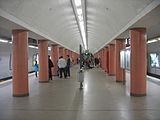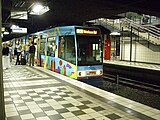
Stadtbahn is a German word referring to various types of urban rail transport. One type of transport originated in the 19th century, firstly in Berlin and followed by Vienna, where rail routes were created that could be used independently from other traffic.

The Frankfurt U-Bahn is a Stadtbahn (premetro) system serving Frankfurt, Hesse, Germany. Together with the Rhine-Main S-Bahn and the Frankfurt Straßenbahn, it forms the backbone of the public transport system in Frankfurt. Its name derives from the German term for underground, Untergrundbahn. Since 1996, the U-Bahn has been owned and operated by Stadtwerke Verkehrsgesellschaft Frankfurt am Main (VGF), the public transport company of Frankfurt, and is part of the Rhein-Main-Verkehrsverbund (RMV) transport association. The licence contract is up to 31 December 2031 and is renewable. The contracting authority of VGF is the municipal transport company traffiQ.

The Hanover Stadtbahn is a Stadtbahn system in the city of Hanover, Lower Saxony, Germany. The Stadtbahn opened on 29 September 1975, gradually replacing the city's tramway network over the course of the following 25 years. Currently, the Hanover Stadtbahn system consists of 12 main lines, serving 201 stations, and operating on 121 kilometres (75 mi) of route. The system is run by üstra, which was originally an abbreviation for Überlandwerke und Straßenbahnen Hannover AG. As of 2007, it transported 125 million passengers per year.

Köln Hauptbahnhof is the central railway station of Cologne, Germany. The station is an important local, national and international transport hub, with many ICE, Eurostar and Intercity trains calling there, as well as regional Regional-Express, RegionalBahn and local S-Bahn trains. EuroNight and Nightjet night services also call at the station. It has frequent connections to Frankfurt by way of the Cologne–Frankfurt high-speed rail line, which starts in southern Cologne. On an average day, about 280,000 travellers frequent the station, making it the fifth busiest station in Germany.

The Cologne Stadtbahn is a light rail system in the German city of Cologne, including several surrounding cities of the Cologne Bonn Region. The term Stadtbahn denotes a system that encompasses elements of trams as well as an underground railway network (U-Bahn) and interurban rail, even including three lines that are licensed as heavy rail and used by freight trains as well as Stadtbahn vehicles. Two of these lines connect the Cologne Stadtbahn to the Bonn Stadtbahn. These lines are jointly operated by both cities' transport authorities, resulting in both systems and the lines connecting them sometimes collectively referred to as Stadtbahn Rhein-Sieg.

The Stuttgart Stadtbahn is a semi-metro system in Stuttgart, Germany. The Stadtbahn began service on 28 September 1985. It is operated by the Stuttgarter Straßenbahnen AG (SSB), which also operates the bus systems in that city. The Stuttgart Stadtbahn is successor system of a tram network (Straßenbahnen) that characterized the urban traffic in Stuttgart for decades.

The Vienna S-Bahn is a suburban commuter rail network in Vienna, Austria. As opposed to the city-run urban metro network, the Vienna U-Bahn, it extends beyond the borders of the city, is operated by the ÖBB, and consists of many branch lines. S-Bahn is short for Schnellbahn, which can be translated as "rapid railway".

Trams make an important contribution to public transport in the city of Zürich in Switzerland. The tram network serves most city neighbourhoods, and is the backbone of public transport within the city, albeit supplemented by the inner sections of the Zürich S-Bahn, along with urban trolleybus and bus routes, as well as two funicular railways, one rack railway and passenger boat lines on the river and on the lake. The trams and other city transport modes operate within a fare regime provided by the cantonal public transport authority Zürcher Verkehrsverbund (ZVV), which also covers regional rail and bus services.

Bielefeld Hauptbahnhof is the main station in the region of Ostwestfalen-Lippe, in the German state of North Rhine-Westphalia. It is an important station because of the size of the city of Bielefeld and its location at the Bielefeld Pass, which makes it a node for long-distance and regional traffic. It was opened in 1847 with the opening of the Cologne-Minden trunk line. It is classified by Deutsche Bahn as a category 2 station.
The Bonn Stadtbahn is a Stadtbahn system in Bonn and the surrounding Rhein-Sieg area, that also includes the Bonn Straßenbahn. Although with six actual Stadtbahn lines the network is relatively small, two of Bonn's Stadtbahn lines connect to the much larger Cologne Stadtbahn.

The Karlsruhe Stadtbahn is a German tram-train system combining tram lines in the city of Karlsruhe with railway lines in the surrounding countryside, serving the entire region of the middle upper Rhine valley and creating connections to neighbouring regions. The Stadtbahn combines an efficient urban railway in the city with an S-Bahn, overcoming the boundary between trams and trains. Its logo does not include the green and white S-Bahn symbol used in other German suburban rail systems and the symbol is only used at stops and stations outside the inner-city tram-operation area.

The Bochum Stadtbahn is a light rail line in North Rhine-Westphalia, Germany, linking the cities of Bochum and Herne. It is operated by BOGESTRA, and is integrated into the Rhine-Ruhr Stadtbahn network. It consists of a single Stadtbahn line, which includes a tunnel section between the city centers of Bochum and Herne.
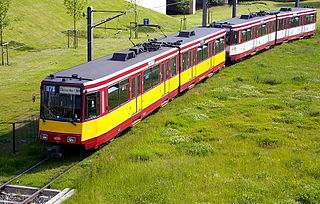
The Düsseldorf Stadtbahn is a Stadtbahn serving Düsseldorf and surrounding areas in the Rhine-Ruhr metropolitan region of the German state of North Rhine-Westphalia. Together with the S-Bahn Rhein-Ruhr, the Stadtbahn forms the backbone of the local public transport system in the city, which is supplemented by other tram and bus lines. On some lines, the light rail operates beyond the city limits of Düsseldorf to the neighboring cities of Neuss, Meerbusch, Krefeld, Duisburg and Ratingen.
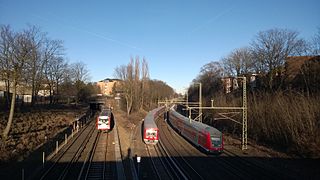
Rapid transit in Germany consists of four U-Bahn systems and 14 S-Bahn systems. The U-Bahn, commonly understood to stand for Untergrundbahn, are conventional rapid transit systems that run mostly underground, while the S-Bahn or Stadtschnellbahn are commuter rail services, that may run underground in the city center and have metro-like characteristics in Munich, Hamburg and Berlin which they only have to a lesser extent in other cities. There are also over a dozen semi-metro or Stadtbahn systems that are rapid transit in the city center and light rail outside.
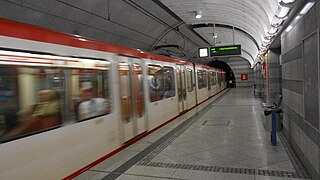
The Dortmund Stadtbahn is a light rail system in the German city of Dortmund and is integrated in the Rhine-Ruhr Stadtbahn network. Its network consists of eight lines and is operated by Dortmunder Stadtwerke, which is operating under the brand DSW21 since 2005.

The Darmstadt tram network is a light rail system and the backbone of public transport within Darmstadt, a city in the federal state of Hesse, Germany. As of 2014, nine lines on four main routes serve 162 stops, including 92 low-floor stops. The system is operated by HEAG mobilo, and is an integral part of the Rhein-Main-Verkehrsverbund (RMV), the public transit authority of the Rhein-Main-Area.

The Nuremberg tramway network is a network of tramways forming part of the public transport system in Nuremberg, a city in the federal state of Bavaria, Germany. The system reached the neighboring city of Fürth from its opening year to almost a century later when construction of the U1 subway line led to the withdrawal of tram service to and within Fürth. During that era and referring to it historically in literature or nostalgic activities, the system was known as “Nürnberg-Fürther Straßenbahn“. For example, a local association dedicated to preserving the history and heritage of the tram network as well as old rolling stock calls itself “Freunde der Nürnberg-Fürther Straßenbahn“ The system is planned to cross the municipal boundaries of Nuremberg once more, if and when the extension to Erlangen and from there to Herzogenaurach dubbed "Stadtumlandbahn" opens.
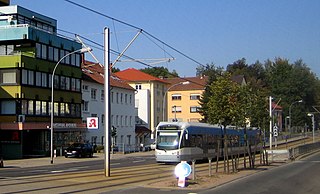
The Saarbahn is a regional Stadtbahn operating on the tram-train principle in the German state of the Saarland. It consists of a core line in Saarbrücken and Riegelsberg operating under tram operating procedures (BOStrab), connected to two lines that are operated under railway operating procedures (EBO), the Lebach–Völklingen railway to the north and the Saarbrücken–Sarreguemines railway in the south. Stadtbahn Saar GmbH is responsible for the infrastructure of the central section of line, while the outer tracks are operated by the national railway infrastructure companies, DB Netz AG in Germany and Réseau Ferré de France in France. The system is operated by Saarbahn GmbH, and integrated in the Saarländischer Verkehrsverbund (SaarVV).

The Essen Stadtbahn is a 19.6-kilometer (12.2 mi) light rail (Stadtbahn) network in Essen and the two neighbouring towns of Mülheim an der Ruhr and Gelsenkirchen in the German state of North Rhine Westphalia. It forms part of the Rhine-Ruhr Stadtbahn.

The Bonn tramway network forms part of the public transport system in the city Bonn, North Rhine-Westphalia, Germany, along with the Bonn Stadtbahn with which the tramlines are heavily integrated. The tram network consists of three tram lines which makes Bonn's tramway relatively small, as it comprises only 29.52 kilometres (18.34 mi) of route. The tramway is operated by 24 low-floor tramcars.




